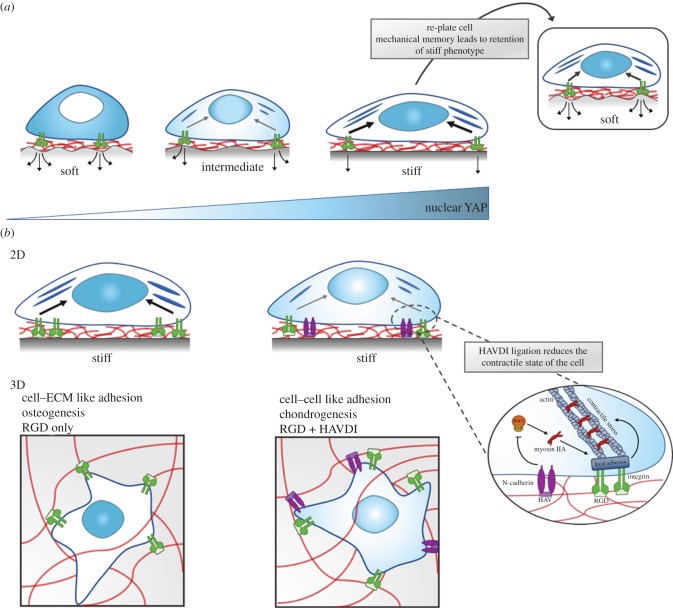Figure 3.
MSC mechanosensing of ECM stiffness cues. (a) Cell mechanosensing through integrin–ECM (in this case fibronectin RGD domain) detect changes in underlying matrix stiffness, as matrix stiffness increases so does the cytoplasmic-to-nuclear import of Yes-associated protein and its transcriptional co-activator (YAP/TAZ). YAP/TAZ is a master transcriptional regulator of many functional downstream effects, including differentiation of MSCs. MSCs will preferentially differentiate into osteoblasts on stiff matrices, and soft tissue types (such as adipose tissue) on soft matrices, hence increased nuclear import of YAP/TAZ on stiff substrates attenuates osteogenic differentiation of MSCs. In MSCs that are preconditioned on a stiff substrate, and then re-plated to a softer substrate, YAP/TAZ signalling remains active, and the cells remain committed to an osteogenic differentiation profile, i.e. they retain mechanical memory. (b) Modification of materials to contain specific peptide sequences can modulate mechanosensitive pathways. By addition of N-cadherin-based interactions, that mimic cell–cell contact (HAV motif—histidine, alanine and valine), pathways triggered by soft substrates are activated, and the contractile state of the cell is reduced. Whereas integrin-based interactions mimic cell–ECM contact (RGD—arginine, glycine and aspartic acid), leading to focal adhesion formation, which generates intracellular tension. HAV/N-cadherin interactions inhibit Rac-GTP levels, decreasing myosin IIA–actin interactions, reducing the recruitment of proteins to integrins to form focal adhesions, and hence reducing the contractile force generation on the cytoskeleton. Cells thereby behave as though on a softer substrate if HAV/N-cadherin ligation is present. In three-dimensional materials, peptide modifications such as this can mediate control over osteogenic or chondrogenic differentiation. Chondrocytes typically reside in pairs, meaning cell–cell interactions are preferable to cell–matrix interactions, i.e. presence of cadherin binding sites leads to chondrogenesis. Adapted from references [65,66]. (Online version in colour.)

